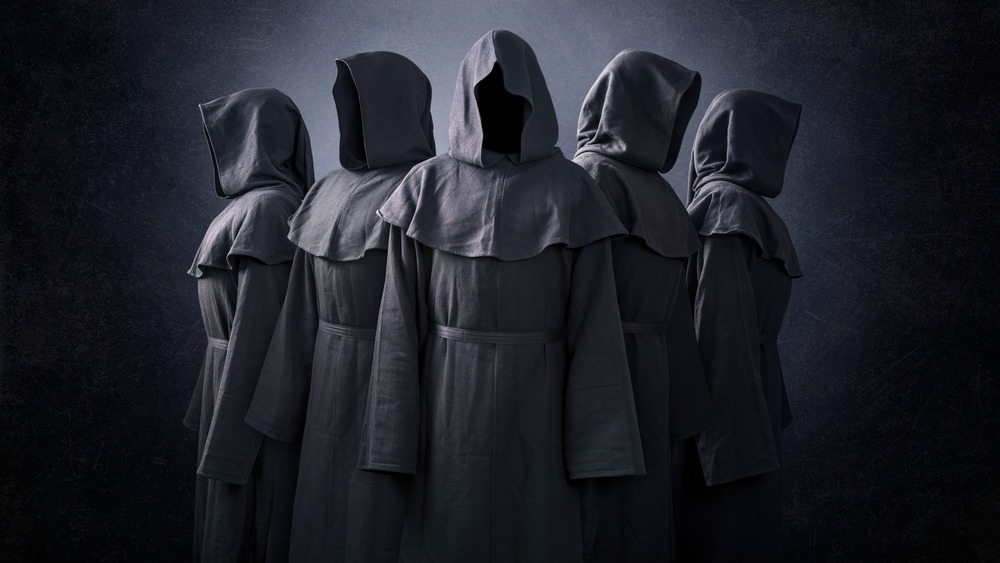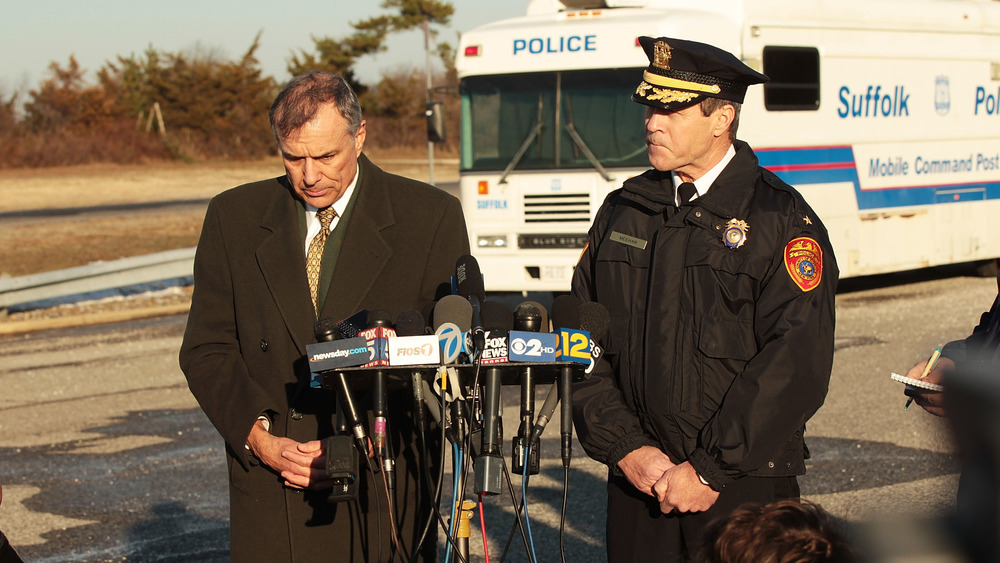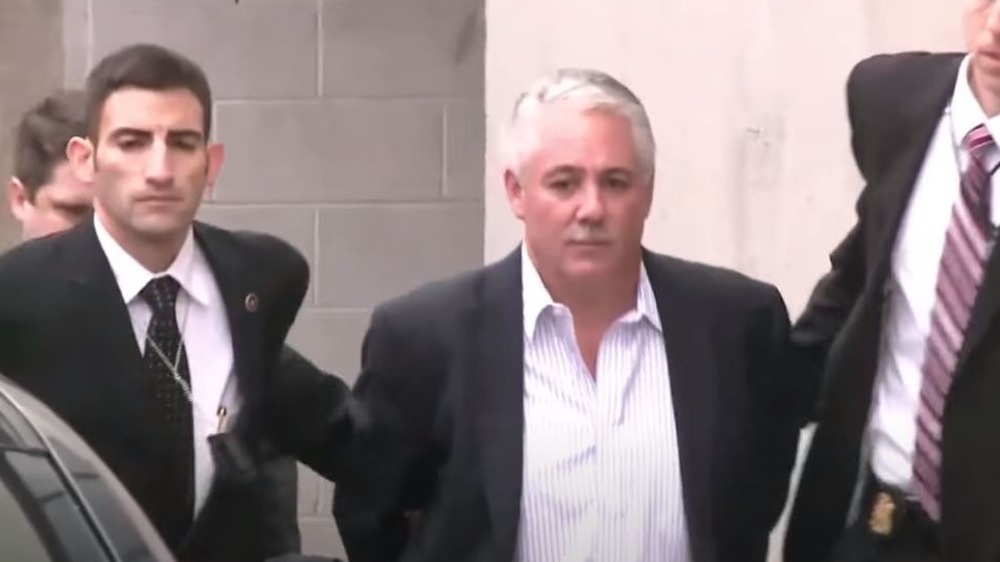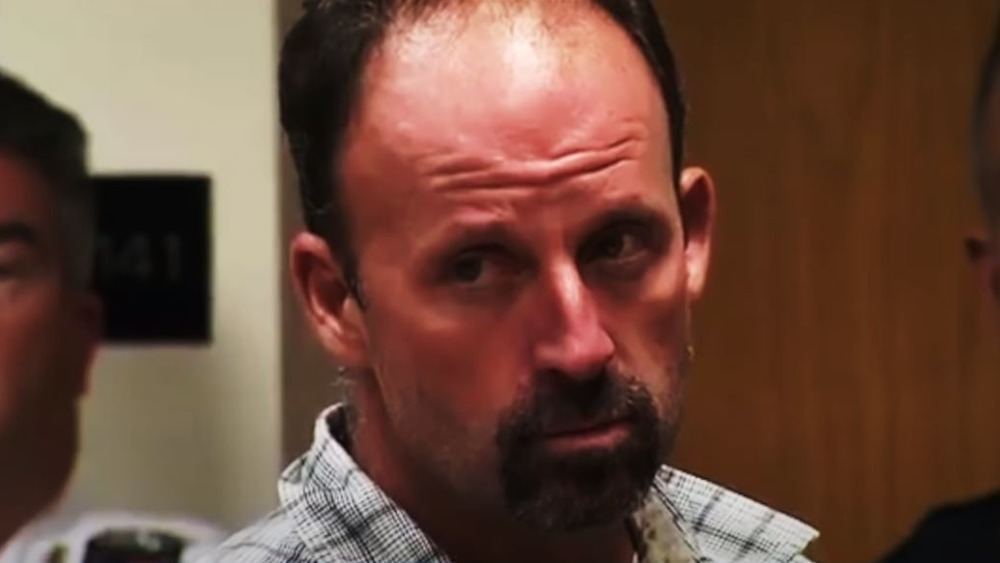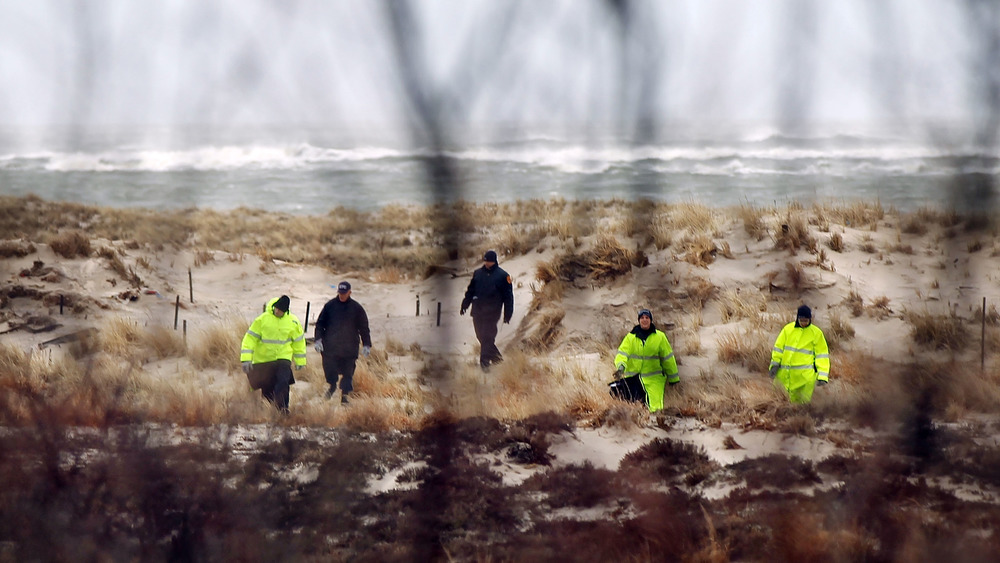The Real Reason The Long Island Serial Killer Murders Remain Unsolved
There are serial killers among us. This is a fact of life that's as unfortunate as it is terrifying, and as such, it's easy to believe that whenever authorities catch a whiff of one, they descend on these societal boogeymen like a ton of furious bricks. What to do, then, when a strange group of crimes in an area seems to have all the makings of a potential serial killer case, yet the police can't — or won't — make any progress in the investigation? What to think when body after body surfaces, yet every suspect or lead seems to evaporate without yielding a single clue about the mystery at hand?
Such a scenario is almost too terrifying to imagine — and, unfortunately, there's no need to do so. New York's Long Island has been struggling with exactly this kind of situation for well over a decade, and the eerie mystery of the numerous bodies found on Gilgo Beach and nearby areas continues to haunt the area. Today, we'll take a look at the Long Island serial killer murders, and the reason they remain unsolved.
(Fair disclaimer: As you can probably guess, some of the following stuff is going to be pretty awful.)
The bodies were found while searching for a completely different person
The Long Island serial killer mystery came to light in a characteristically strange way. As Rolling Stone reports, on May 1, 2010, a 24-year-old sex worker named Shannan Gilbert went missing in Long Island. Per Vice, her disappearance was preceded by a call to 911, during which she said: "They are trying to kill me." Some say the call was frantic, and she sounded extremely frightened. The police, on the other hand, have said that she seemed quite composed. Regardless of Gilbert's tone, the call's intentions remain a mystery. Though CBS News points out she was with her driver and a client named Joseph Brewer at the time, an official who's heard the call has stated that the bipolar Gilbert sounded irrational.
Gilbert ran from the house and attempted to get help from neighbors. Some people were alerted by her strange behavior and called the police, but at that point, she'd already disappeared. The police didn't find a body until December 10 of that year, at which point another problem surfaced: It wasn't Gilbert's.
This grisly discovery led to others, and the creepy story of the suspected Long Island serial killer started to come to light. Unfortunately, things didn't end much better for Gilbert, either. Per NBC New York, her remains were found in December 2011 in a nearby marshland. The police believed that she'd drowned ... though it's worth mentioning that she was missing two neck bones.
The number of serial killers is uncertain
When the search for Shannan Gilbert started turning up bodies that weren't her, things got all sorts of confusing, per Rolling Stone. The first four victims — called the Gilgo Four because they were found near a remote stretch known as Gilgo Beach — were all young, slender sex workers. As CBS News tells us, all of them were discovered shrouded in burlap. The area is roughly three miles away from where Gilbert's remains would eventually be found.
By the time Gilbert's skeleton was discovered, a total of ten victims had been found. According to The New York Times, the total number of victims found in the area between Gilgo Beach and Manorville is as high as 16. However, it's hard to say just how many of them are connected. While the Gilgo Four and a number of other victims fit a very specific modus operandi, there were others who didn't quite fit the bill — Vice notes that one victim was a small child, and another was a trans woman. A common cause of death was strangling or other method of oxygen deprivation, but some of the bodies had been dismembered and wrapped in plastic.
Likewise, it's unclear whether all of these deaths are the work of one person or several. If there are more than one, do they just happen to use the same remote area to dump their victims? Or are they working together?
A seemingly random doctor inserted himself into the situation
As CBS News tells us, the two men who'd been present when Shannan Gilbert ran in the night, Joseph Brewer and driver Michael Pak, were soon cleared as suspects. However, another man who supposedly encountered Gilbert on that fateful night was a stranger case. Mere days after Gilbert went missing, area resident Dr. Peter Hackett called Shannan's mother, Mari, and claimed that he'd taken her into his halfway house. When the missing woman's sisters went to visit him, they say he denied the whole thing. It's been verified that Hackett indeed made a call, but he still denies meeting Shannan, let alone telling Mari Gilbert about such an encounter.
Authorities have stated that they're aware of Hackett but don't consider him a suspect. "He's an individual who likes to get involved," former Chief of Detectives Dominck Varrone said. "Some call him a storyteller and an exaggerator. We certainly believe that he may have called to offer his assistance." Gilbert's family, on the other hand, remained more suspicious. Per The Tab, Mari Gilbert even slapped him with a wrongful death lawsuit, based on Hackett supposedly telling her on the phone that he'd given medicine to Shannan.
More recently, Hackett has seemed to do his best to avoid the case. In one incident, a Crime Watch Daily camera crew confronted him, and he dodged the situation by collapsing on the ground and insinuating that his defibrillator was giving him chest pains.
Armchair detective theories have muddied the waters
As a mysterious, unsolved, relatively timely case, it's no surprise that the Long Island serial killer mystery has become popular among amateur Sherlocks. Per Vice, many of them are convinced that the curious Dr. Peter Hackett is either a murderer or a handy patsy that has been used to draw blame from the real murderer. However, that's just the beginning of a conga line of increasingly inspired theories about conspiracy and mayhem that have been making rounds online.
As The New York Times tells us, some are convinced that an incredibly efficient killer is haunting beach areas of the East Coast. Others go with the "satanic sex cult did it" angle that has, perhaps predictably, come up in some conspiracy theorist circles. The case is so mysterious that a single Reddit thread can yield theories that range from a BTK Killer-style murderer who varies his methods to a deadly drug addict whose efficiency as a killer depends on what he happens to have in his system.
The media, of course, has occasionally gotten in on the action. At one point, Newsday (via Gothamist) suspected an already convicted serial killer named Joel Rifkin of some of the Long Island serial killer murders. Rifkin adamantly denied these claims ... and offered some theories of his own. "My guess is it would be someone like a landscaper, contractor or a fisherman," he speculated about people who might be able to dump bodies in the area unnoticed.
The Suffolk Police shut down in a strange way
A very peculiar aspect of the Long Island serial killer case has been the detached way the Suffolk police handled it, according to The New York Times. Shannan Gilbert's family had serious trouble getting the authorities to treat her as a missing person, and although several bodies had already turned up by the time her remains were discovered in December 2011, they seemed to actually wind the investigation down after that. They went as far as calling off all collaboration with the FBI and other potentially helpful institutions, letting the case linger in a strange stasis for years. Until recently, local police higher-ups have avoided bringing up the case, and the police in general have seemed to drag their feet and even show contempt toward the victims. One detective has even stated that the fact that the victims were "only" sex workers is a "consolation."
As the Long Island Press tells us, this attitude did not go unnoticed, and it was largely caused by a desire to avoid drawing too much attention to the shady dealings within the police department's own ranks. As investigative journalist Billy Jensen put it: "I've never worked a story where the law enforcement and the people in power were as cagey as the potential suspects."
A police chief allegedly hampered the investigation
Suffolk County's former police chief, James Burke, was in hot water in 2015. Per the New York Post, he had long fielded accusations of keeping the FBI at arm's length from the Long Island serial killer investigation. When he was brought to justice for allegedly assaulting a handcuffed suspect and trying to cover it up, this promptly returned to haunt him. According to PIX11, an attorney for Shannan Gilbert's family, John Ray, came forward with a sworn statement from a sex worker who said that she'd witnessed Burke use drugs and party with sex workers on two occasions, at least one of which took place in 2011 — which means he was doing this while the Long Island serial killer investigation was taking place, in the Oak Beach neighborhood where Gilbert was found.
Per The New York Times, Burke ended up resigning from his position. He pleaded guilty for the assault in 2016 and was released from prison in 2019. However, his exposure revealed a network of corruption and scandal that took down some of the county's top officials. Per the Long Island Press, there's still plenty of interest in Burke's role in the Long Island serial killer investigation, too. "The very best case scenario is that he sabotaged the investigation to cover up his own illicit behavior, whether that's indulging in sex workers or drug use," true crime documentary maker Alexis Linkletter said. "That's really the best case scenario, which is not good."
A potential suspect is already in prison
In 2017, prosecutor Robert Biancavilla stirred up the stagnant Long Island serial killer investigation by introducing a potential suspect, per People. The person was John Bittrolff, a carpenter who's currently serving a sentence of "at least 50 years" for strangling two sex workers to death in Long Island. The crimes happened in the 1990s, but as PIX11 tells us, he didn't get caught until 2014.
Due to the fact that Bittrolff lived in the area, targeted sex workers, and murdered them in a way that was quite similar to many Long Island serial killer victims, he evidently became a noteworthy guy in the authorities' eyes. "There are remains of the victims at Gilgo that may be attributed to the handiwork of Mr. Bittrolff, and that investigation is continuing," Biancavilla said.
As an interesting note about Bittrolff's potential involvement in the Long Island serial killer case: One of the victims, Melissa Barthelemy, went missing in 2009. Her case is notorious for the number of nasty calls her little sister received from Melissa's phone — presumably from the killer, who also outed Melissa's sex worker status to her family. When Bittrolff was named as a potential Long Island serial killer suspect, the family revealed that Melissa's job and his Long Island hamlet community of Manorville were connected. "I don't know what to think, because Melissa had a lot of calls to Manorville from her phone, and that is where this guy is from," the victim's mother said.
The killer might already be dead
One theory about the Long Island serial killer — or one killer, anyway — is that the reason he hasn't been caught is the very simple fact that he's dead. Per KFGO, the co-owner of the Long Island Nursery, James Bissett, seemed to fit the bill quite conveniently ... at least, according to local whispers. As the New York Post tells us, Bissett was a wealthy man, which fit the investigators' theories about a financially self-sufficient killer, and according to Entertainment Daily, his company was a major burlap supplier, which gave him ample access to the material some of the bodies were wrapped in. Oh, and there's also the fact that he ended his own life in 2011, soon after the authorities found the remains of Shannan Gilbert.
On paper, this does seem like a pretty suspicious combination, and reportedly, the gossip-inclined folks in the area indeed came up with all sorts of possible motives for his suicide. However, the investigators didn't share this opinion, and as of at least 2015, the official stance has been that Bissett isn't a suspect for any of the Long Island murders.
If you or anyone you know is having suicidal thoughts, please call the National Suicide Prevention Lifeline at 1-800-273-TALK (8255).
The Long Island serial killer investigation was resurrected in 2018
As The New York Times tells us, the year 2018 saw a dramatic change in the way the investigation of the Long Island serial killer case was handled. This is largely because the Suffolk County Police Department got a new commissioner, Geraldine Hart. Where some of her predecessors had cut the federal authorities out of the investigation, she was a former FBI agent herself, with 15 years in their organized crime division under her belt. While other commishes had largely tiptoed around the subject, she has proven happy to discuss it — and, having been on the FBI side of things during the discovery of the Gilgo Four, presumably knows full well just how badly the police's handling of the case has been perceived.
Hart has already brought the FBI back in the mix and made progress in the proceedings. In 2020, she announced that her investigators had uncovered the identity of "Jane Doe No. 6," one of the dismembered victims. Though some of Valerie Mack's remains had already been found in plastic bags as early as 2000, she also counted among the bodies found in the vicinity of Gilgo Beach in 2011. The discovery of her identity proved important because they could now track her movements before her disappearance — interestingly, she has been tracked down to Philadelphia before she went missing — but it was also a sign that the investigation was once again a serious endeavor.
DNA records may one day provide an answer to the mystery
Though the Long Island serial killer case is still open, the future isn't hopeless. As The New York Times reports, Commissioner Geraldine Hart has proved eager to grab this particular bull by the horns. As a FBI veteran, she's open to several lines of investigation and also far more open about the case than the public is used to. "There's a lot of work left to do," she's said. "But there is momentum. And I'm going to continue to use that momentum to move forward."
One enticing possibility for bringing the investigation forward is DNA evidence. Valerie Mack, a victim previously known as "Jane Doe No. 6," was identified thanks to her aunt's DNA, found on a genealogy site. Even more importantly, the infamous Golden State Killer was finally caught in 2018, using new DNA tech opportunities that uncovered hitherto unseen information.
The Long Island investigation seems to be focusing their DNA efforts on identifying the remaining Jane Does, since they have no DNA samples of the killer — or do they? In 2020, Hart introduced to the public a very peculiar, initialed belt, which is believed to be connected to the killer. It's not much, but it's more than the world knew a few years ago. Just imagine what we might find out tomorrow.




